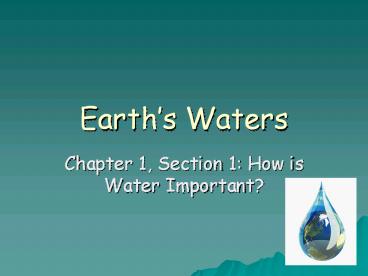Earth - PowerPoint PPT Presentation
Title:
Earth
Description:
Earth s Waters Chapter 1, Section 1: How is Water Important? Learning Objectives: Students should be able to: *Give examples of how people and other living things ... – PowerPoint PPT presentation
Number of Views:120
Avg rating:3.0/5.0
Title: Earth
1
Earths Waters
- Chapter 1, Section 1 How is Water Important?
2
- Learning Objectives Students should be able to
- Give examples of how people and other living
things use water. - Identify how earths water is distributed
among salt and fresh water sources.
3
Section 1 Vocab
- 1. Irrigation- the process of supplying water to
areas of land to make them suitable for growing
crops.
4
Section 1 Vocab
- 2. Photosynthesis-the process that plants use to
make food from water, carbon dioxide, and energy.
5
Section 1 Vocab
- 3. Habitat-The place where the organisms lives
and provides the things it needs to survive.
6
Section 1 Vocab
- 4. Water Vapor-the gaseous form of water.
7
Section 1 Vocab
- 5. Ground water-water that fills the cracks and
spaces in underground soil and rock layers.
8
Notes1. 5 Major uses of Water in the U.S.
- Household Purposes
- Agriculture
- Industry
- Transportation
- Recreation
9
Water on Earth
435
- 2. Question It takes ______ liters of water to
grow the wheat to make a single loaf of bread!
10
Water and Living Things
- 3. Water is essential for living things to
- Grow
- Reproduce
- And carry out other important processes.
11
Distribution of Water
97
- 4. Question More than _____ of Earths water
is ____ water that is found mainly in the oceans.
salt
12
Water on Earth
1
- 5. Question Less than ____of the water on Earth
is available for human use.
13
Water Conservation videos
- Why waste today when you can save for tomorrow.
http//www.youtube.com/watch?vhC9uVM162BI - Water Conservation Commercial http//www.youtube.
com/watch?v1BHQ170BVcMNR1 - Save Water http//www.youtube.com/watch?v69Kd7F9
BU08featurerelated - Home water saving tips http//www.youtube.com/wat
ch?vrRsiz5ykjuc - Energy Conservation for kids http//www.youtube.
com/watch?vXz8sVG6GVWw
14
Earths Waters
- Chapter 1, Section 2 Property of Water
15
- Learning Objectives You should be able to
- describe the physical and chemical properties
of water. - explain how water dissolves other polar
substances - identify three states in which water exists on
Earth.
16
Vocab
- 6. Polar Molecule-A molecule that has
electrically charged areas.
17
Vocab
- 7. Surface Tension-The tightness across the
surface of water that is caused by the polar
molecules pulling on each other.
18
Vocab
- 8. Capillary Action-the combined force of
attraction among water molecules and with the
molecules of surrounding materials. - Capillary action allows water to move through
materials with pores or narrow spaces inside.
19
Vocab
- 9. Solution-A mixture that forms when one
substance dissolves another.
20
Vocab
- 10. Solvent-The substance that does the
dissolving. - Water is the solvent when you make lemonade from
a powdered mix. - Water is the universal solvent.
21
- 11. State-forms solid, liquid, and gas.
22
- 12. Evaporation-the process by which molecules at
the surface absorb enough energy to change the
gaseous state.
23
- 13. Condensation-the process by which a gas
changes to a liquid.
24
- 14. Specific Heat-the amount of heat needed to
increase the temperature of a certain mass of a
substance by 1OC.
25
Notes
- 1. Question A short way to write the chemical
formula for water is ______
H20
26
Notes
One
- 2. Water is made of ____negative atom of _____
and _____positive atoms of______.
two
oxygen
hydrogen
27
Notes
Surface tension
- 3. ________ ________ causes raindrops to form on
windshields.
28
Notes
- 4. Ice tea and lemonade are common ____________.
solutions
29
Notes
- 5. One reason that water can _________many
substances is that it is ________.
dissolve
polar
30
Notes
- 6. Three factors that affect dissolving
- A.
- B.
- C.
Stirring
Particle Size
Temperature
31
Notes
Oil
- 7. Some substances such as _________ and
_________ will not dissolve in water because they
are__________. - Non polar-A molecule in which the electrons are
shared equally between the nuclei.
Wax
Non polar
32
- 8. Air drying your hair is an example
of______________.
Evaporation
33
- 9. Fogging up a bathroom mirror is an example
of _______________.
Condensation
34
less
- 10. Ice is ________dense than liquid water.
35
Earths Waters
- Chapter 1, Section 3 The Water Cycle
36
Learning Objectives
- to describe how earths water moves through the
water cycle. - list ways that living things depend on the
water cycle.
37
Vocab
- Water cycle- the continuous process by which
water moves through the living and non living
parts of the environment. - In the water cycle, water moves from bodies of
water, land, and living things on Earths surface
to the atmosphere and back to Earths surface.
38
Vocab
- Transpiration-The process in which water is given
off through the leaves of plants.
39
Vocab
- Precipitation-Water that falls to the earth as
rain, snow, hail, or sleet.
40
Notes
Suns
- 1. The _________ energy drives the water cycle.
41
Water Cycle
- Video http//www.youtube.com/watch?v0_c0ZzZfC8c
featurerelated
42
Water Cycle Review-
- http//livingclassrooms.org/slurrp/watercycle.html
43
(No Transcript)
44
Notes
- 2. Three places from which water evaporates
- A.
- B.
- C.
Surface of oceans and large lakes
Small amounts from the soil, puddles, and your
skin
Significant amount given off by plants
45
Notes
water
- 3. Condensed droplets of _________ clump together
around ________ particles in the air
forming__________.
tiny dust
clouds
46
Notes
- 4. Most water molecules spend only about ____
days in the atmosphere before falling back to
Earth.
10































